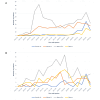Real-World Data Quality Framework for Oncology Time to Treatment Discontinuation Use Case: Implementation and Evaluation Study
- PMID: 38446504
- PMCID: PMC10955397
- DOI: 10.2196/47744
Real-World Data Quality Framework for Oncology Time to Treatment Discontinuation Use Case: Implementation and Evaluation Study
Abstract
Background: The importance of real-world evidence is widely recognized in observational oncology studies. However, the lack of interoperable data quality standards in the fragmented health information technology landscape represents an important challenge. Therefore, adopting validated systematic methods for evaluating data quality is important for oncology outcomes research leveraging real-world data (RWD).
Objective: This study aims to implement real-world time to treatment discontinuation (rwTTD) for a systemic anticancer therapy (SACT) as a new use case for the Use Case Specific Relevance and Quality Assessment, a framework linking data quality and relevance in fit-for-purpose RWD assessment.
Methods: To define the rwTTD use case, we mapped the operational definition of rwTTD to RWD elements commonly available from oncology electronic health record-derived data sets. We identified 20 tasks to check the completeness and plausibility of data elements concerning SACT use, line of therapy (LOT), death date, and length of follow-up. Using descriptive statistics, we illustrated how to implement the Use Case Specific Relevance and Quality Assessment on 2 oncology databases (Data sets A and B) to estimate the rwTTD of an SACT drug (target SACT) for patients with advanced head and neck cancer diagnosed on or after January 1, 2015.
Results: A total of 1200 (24.96%) of 4808 patients in Data set A and 237 (5.92%) of 4003 patients in Data set B received the target SACT, suggesting better relevance of the former in estimating the rwTTD of the target SACT. The 2 data sets differed with regard to the terminology used for SACT drugs, LOT format, and target SACT LOT distribution over time. Data set B appeared to have less complete SACT records, longer lags in incorporating the latest data, and incomplete mortality data, suggesting a lack of fitness for estimating rwTTD.
Conclusions: The fit-for-purpose data quality assessment demonstrated substantial variability in the quality of the 2 real-world data sets. The data quality specifications applied for rwTTD estimation can be expanded to support a broad spectrum of oncology use cases.
Keywords: UReQA framework; Use Case Specific Relevance and Quality Assessment; data quality assessment; real-world data; real-world time to treatment discontinuation; systemic anticancer therapy.
©Boshu Ru, Arthur Sillah, Kaushal Desai, Sheenu Chandwani, Lixia Yao, Smita Kothari. Originally published in JMIR Medical Informatics (https://medinform.jmir.org), 06.03.2024.
Conflict of interest statement
Conflicts of Interest: BR, KD, and SK report employment with Merck Sharp & Dohme LLC, a subsidiary of Merck & Co, Inc, Rahway, NJ, United States, and stock ownership of Merck & Co, Inc, Rahway, NJ, United States. AS reports employment with Real World Evidence, Epidemiology, Medical Affairs and Value Statistics (REM) Data Science department, Jazz Pharmaceutical. SC reports employment with ConcertAI. LY reports employment with and ownership of Polygon Health Analytics LLC. AS, SC, and LY were employees of Merck Sharp & Dohme LLC, a subsidiary of Merck & Co, Inc, Rahway, NJ, United States, when they worked on this study.
Figures

Similar articles
-
Thirty-day mortality after systemic anticancer treatment as a real-world, quality-of-care indicator: the Northland experience.Intern Med J. 2018 Apr;48(4):403-408. doi: 10.1111/imj.13618. Intern Med J. 2018. PMID: 28872748
-
Comparing Findings From a Friends of Cancer Research Exploratory Analysis of Real-World End Points With the Cancer Analysis System in England.JCO Clin Cancer Inform. 2021 Dec;5:1155-1168. doi: 10.1200/CCI.21.00013. JCO Clin Cancer Inform. 2021. PMID: 34860576 Free PMC article.
-
Evaluation of Real-World Tumor Response Derived From Electronic Health Record Data Sources: A Feasibility Analysis in Patients With Metastatic Non-Small Cell Lung Cancer Treated With Chemotherapy.JCO Clin Cancer Inform. 2024 Aug;8:e2400091. doi: 10.1200/CCI.24.00091. JCO Clin Cancer Inform. 2024. PMID: 39146509 Free PMC article.
-
A systematic review of non-standard dosing of oral anticancer therapies.BMC Cancer. 2018 Nov 22;18(1):1154. doi: 10.1186/s12885-018-5066-2. BMC Cancer. 2018. PMID: 30466406 Free PMC article.
-
Systemic Anticancer Treatment Near the End of Life: a Narrative Literature Review.Curr Treat Options Oncol. 2023 Oct;24(10):1328-1350. doi: 10.1007/s11864-023-01115-x. Epub 2023 Jul 27. Curr Treat Options Oncol. 2023. PMID: 37501037 Free PMC article. Review.
Cited by
-
Bridging Data Silos in Oncology with Modular Software for Federated Analysis on Fast Healthcare Interoperability Resources: Multisite Implementation Study.J Med Internet Res. 2025 Apr 15;27:e65681. doi: 10.2196/65681. J Med Internet Res. 2025. PMID: 40233352 Free PMC article.
References
-
- Miksad RA, Samant MK, Sarkar S, Abernethy AP. Small but mighty: the use of real-world evidence to inform precision medicine. Clin Pharmacol Ther. 2019 Jul;106(1):87–90. doi: 10.1002/cpt.1466. https://europepmc.org/abstract/MED/31112289 - DOI - PMC - PubMed
-
- Desai KD, Chandwani S, Ru B, Reynolds MW, Christian JB, Estiri H. Fit-for-purpose real-world data assessments in oncology: a call for cross-stakeholder collaboration. Value Outcomes Spotlight. 2021 Jun;24:S25. doi: 10.1016/j.jval.2021.04.129. https://www.valueinhealthjournal.com/article/S1098-3015(21)00346-6/fulltext - DOI
-
- Dagenais S, Russo L, Madsen A, Webster J, Becnel L. Use of real-world evidence to drive drug development strategy and inform clinical trial design. Clin Pharmacol Ther. 2022 Jan;111(1):77–89. doi: 10.1002/cpt.2480. https://europepmc.org/abstract/MED/34839524 - DOI - PMC - PubMed
-
- Lakdawalla DN, Shafrin J, Hou N, Peneva D, Vine S, Park J, Zhang J, Brookmeyer R, Figlin RA. Predicting real-world effectiveness of cancer therapies using overall survival and progression-free survival from clinical trials: empirical evidence for the ASCO value framework. Value Health. 2017;20(7):866–75. doi: 10.1016/j.jval.2017.04.003. https://linkinghub.elsevier.com/retrieve/pii/S1098-3015(17)30203-6 S1098-3015(17)30203-6 - DOI - PubMed
LinkOut - more resources
Full Text Sources

